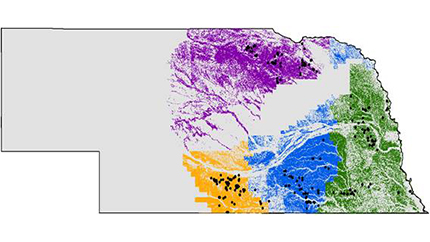In a new study published in Environmental Research Letters, researchers from DWFI and the University of Nebraska–Lincoln found that about a third of producer fields studied successfully achieved high yields within benchmarked irrigation water requirements. This shows that achieving nearly full yield potential and staying below established irrigation water requirements are compatible goals for actual fields in the state. Irrigation water requirements are defined seasonal amounts of irrigation water expected to achieve full yield potential. Yield potential is the maximum yield attained when water and fertilizers are not limited. The authors of the study noted that, in the case of U.S. corn, reaching 80% of yield potential is a reasonable goal.
Researchers collected data for the study from NRDs and through producer surveys. They then developed a framework to diagnose current irrigation water use as it applies to grain production in producer fields. While previous related studies have relied primarily on data from simulations or research farms, the new study used actual producer data from more than 500 corn and soybean producers’ fields in Nebraska.

A striking finding of the study was the fact that yield did not differ between fields using different types of irrigation scheduling. One type of scheduling included methods and technologies that enable more efficient irrigation, including soil water balances, soil moisture sensors and computer irrigation-aid tools, such as CornSoyWater. Another type of scheduling involved “soil feeling,” or visual assessment of plant status. The last type included rudimentary methods, such as basing irrigation on fixed calendar dates or a neighbor’s schedule.
Actual yield of fields in the study averaged 86% of full yield potential across all three scheduling methods. However, fields that used best available technologies to schedule irrigation saw very little water surplus, especially compared to the other two methods, but the fields using best available technology only represented 22% of the total fields. This finding indicates a substantial opportunity to save irrigation water and potentially increase farm profit through adoption of new technologies.
Researchers also found actual irrigation in more than half of the study’s fields to be similar to estimated irrigation water requirements. According to lead researcher and author Kate Gibson of DWFI, this means those producers are doing quite well at achieving high yields with little water surplus. But there is still a lot of potential for reducing water use in the remaining half of the fields studied.
Funding for the work presented in the new publication came from DWFI, Nebraska Corn Board and Nebraska Soybean Board.

